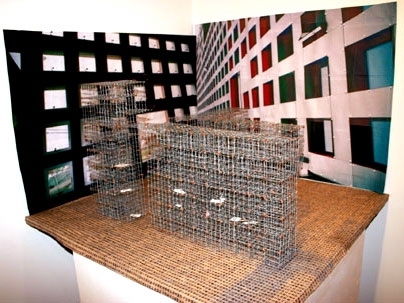Three artists recently asked to dream up public artwork for the city of Cambridge chose MIT for their fantasy projects.
Former MIT artist-in-residence Mary Sherman asked 19 international and local artists to imagine that money was no object and the rules of physics did not apply. The resulting exhibit, "Dimensions Variable, Site Fixed," features models of what the artworks might be like. The exhibit opened this week at the Cambridge Arts Council Gallery.
The show is a dreamscape of creativity, aesthetic beauty and functionality -- with some fascinating reconstructions of unbuildable possibilities.
One of the only guidelines was that the pieces had to make use of existing Cambridge landmarks and architectural sites. Three of the artists -- Sherman (both the curator of the show and a contributing artist), Jin Soo Kim and Pan Ping-Yu -- chose to center works on MIT buildings.
Sherman, artist-in-residence at MIT from 2002 to 2003 in the Department of Mechanical Engineering, chose the MIT Chapel for her work. She proposed installing remote-controlled shooting stars above the chapel at night.
"This would allow us to play gods by rearranging the heavens and, by extension, our destinies," Sherman said. When viewers look into her model, a tall black Plexiglas box with a slit running down the side, they see a model of the chapel and small LED "stars" at the top. When they push a button, one of the "stars" (another tiny LED) "shoots down" from the sky.
Korean artist Jin Soo Kim took a more functional approach to her artwork. Her piece, "Here and There, Now and Then" envisions huge wire cubbies outside MIT's Simmons Hall dormitory.
"Student living space is very limited," said Kim. The cubbies, she said, would be "a site of exchange." Students could place in them things that they no longer wanted or needed -- "clothes, cups, ideas, books, anything" -- and anyone who needed those things could come and take them. "It makes for a living, ever-changing sculpture and reduces landfill waste. This sculpture will become a point of connection for others," she said. "It is a way to simplify your life."
The cubbies would be lined with ancient Confucian writings to inspire students with philosophy from the past, Kim said, hence bringing the past to the present.
Taiwanese artist Pan Ping-Yu imagined a meditation garden for MIT's Stata Center. Pan proposed placing the Tree of Life inside the garden to help balance the elements of mind, body, nature and the environment. The green of the tree in the garden, she said, would provide spirituality to all who enter.
Other pieces in the show include a sidewalk that opens up to a bandstand for street musicians (Peter Lindenmuth) and a gold lam̩ sweater that conceals Harvard University's Science Center (Mary Elizabeth van der Cross).
The exhibit, which runs through Dec. 29, is located at the CAC Gallery, 334 Broadway, Cambridge. For more information, contact Mary Sherman at (617) 464-4086.
A version of this article appeared in MIT Tech Talk on November 16, 2005 (download PDF).






